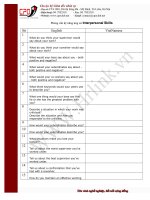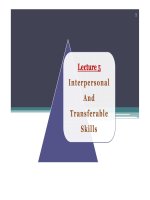Interpersonal communications skills
Bạn đang xem bản rút gọn của tài liệu. Xem và tải ngay bản đầy đủ của tài liệu tại đây (273.17 KB, 100 trang )
Communications - Interpersonal Skills
Participant Guide
NOTES
Table of Contents
Agenda .................................................................................................................... 5
Learning Objectives ................................................................................................ 7
1.0
What is communication?........................................................................... 11
1.1
Sender ................................................................................................... 11
1.2
Message................................................................................................. 11
1.3
Channel ................................................................................................. 12
1.4
Receiver ................................................................................................ 12
1.5
Feedback ............................................................................................... 12
1.6
Barriers.................................................................................................. 12
2.0
Types of communication........................................................................... 27
2.1
Verbal communication.......................................................................... 30
2.2
Non-verbal communication .................................................................. 31
2.3
Listening ............................................................................................... 48
2.3.1
Types of listening.......................................................................... 48
2.3.2
Improving Listening through Feedback........................................ 49
3.0
Ways we communicate ............................................................................. 67
3.1
Speeches................................................................................................ 70
3.2
Presentations ......................................................................................... 70
3.3
Correspondence/Office Communication .............................................. 70
3.4
Telephone.............................................................................................. 70
3.5
Voice Mail ............................................................................................ 71
3.6
Email ..................................................................................................... 71
3.7
Websites................................................................................................ 71
3.8
Blogs ..................................................................................................... 71
4.0
Factors influencing effective communication........................................... 75
4.1
Special needs / accessibility.................................................................. 75
4.2
Environment / setting............................................................................ 75
4.3
Literacy skills........................................................................................ 75
4.4
Cultural factors...................................................................................... 76
4.5
Email etiquette ...................................................................................... 76
4.6
Tone ...................................................................................................... 76
4.7
Respect.................................................................................................. 76
4.8
Gender neutrality .................................................................................. 76
4.9
Jargon.................................................................................................... 76
5.0
Parking Lot................................................................................................ 79
6.0
Discussion/Questions/Summary ............................................................... 79
7.0
Evaluation ................................................................................................. 79
8.0
Appendices................................................................................................ 79
References............................................................................................................. 99
_______________________________________________________________
Communications Module Part 1 - Participant Manual
Government of Newfoundland and Labrador, Department of Innovation, Trade and Rural Development
3
NOTES
_______________________________________________________________
Communications Module Part 1 - Participant Manual
Government of Newfoundland and Labrador, Department of Innovation, Trade and Rural Development
4
Communications Module 1 – Part 1 –
Interpersonal Communications
The Communications Module is designed to be delivered over a two-day period.
The first day is Interpersonal Communications and Day Two is Communications
Planning.
AGENDA
Activity
Icebreaker
Welcome & Overview
Agenda Review
Communication Process
Types of Communication
Verbal
Non-Verbal
Listening
Factors Influencing Communication
Parking Lot
Discussion/Evaluation
_______________________________________________________________
Communications Module Part 1 - Participant Manual
Government of Newfoundland and Labrador, Department of Innovation, Trade and Rural Development
5
NOTES
_______________________________________________________________
Communications Module Part 1 - Participant Manual
Government of Newfoundland and Labrador, Department of Innovation, Trade and Rural Development
6
Learning Objectives
The learning objectives for the Interpersonal Communications module
include:
¾ Understand the fundamentals of basic communication
¾ Identify various types of verbal communication
¾ Discuss various types of non-verbal communication
¾ Analyze communication and listening skills and identify and
practice ways to improve skills
¾ Recognize various factors that influence communication
_______________________________________________________________
Communications Module Part 1 - Participant Manual
Government of Newfoundland and Labrador, Department of Innovation, Trade and Rural Development
7
NOTES
_______________________________________________________________
Communications Module Part 1 - Participant Manual
Government of Newfoundland and Labrador, Department of Innovation, Trade and Rural Development
8
Exercise 1: Getting to know you
Objective
Give participants an opportunity to practice their communication skills
Advance preparation
None
Exercise
Students should pair up to interview each other so that they may learn enough
about the person to introduce him/her to the rest of the group.
Participant resources
Pen/pencil and paper
_______________________________________________________________
Communications Module Part 1 - Participant Manual
Government of Newfoundland and Labrador, Department of Innovation, Trade and Rural Development
9
NOTES
_______________________________________________________________ 10
Communications Module Part 1 - Participant Manual
Government of Newfoundland and Labrador, Department of Innovation, Trade and Rural Development
1.0 What is communication?
Communicating and communication are complex interactions with a
variety of definitions. A short definition is that communication is a
process in which a person, through language, signs and symbols, conveys
a message to another person.
In order to understand the communication process, it is important to
examine the basic elements and their impact on the message. The sender,
message, channel, receiver, noise/distortion and feedback and each will
now be reviewed and discussed.
1.1
Sender
What influences your effectiveness as a sender?
•
•
•
•
1.2
Language and how you use it
Credibility
Knowledge of content, audience and context
Experience, attitudes and values
Message
•
Written
o Words, sentences, paragraphs
•
Oral
o Use of your voice – tone, pitch
•
Non-Verbal
o Gestures
o Facial expressions
o Eye contact
_______________________________________________________________ 11
Communications Module Part 1 - Participant Manual
Government of Newfoundland and Labrador, Department of Innovation, Trade and Rural Development
o Environment (office set up)
1.3
Channel
•
Verbal
o Face to face meetings
o Telephone
o Video-conferencing
•
Written
o Reports
o Letters
1.4
Receiver
When receiver receives the message, communication has taken place.
However, there are several characteristics of receivers that can impact the
message and thus the communication process.
1.5
•
Abilities
•
Attitudes
•
Experience
Feedback
•
Receiver responds in some way
•
Key component as it allows sender to evaluate effectiveness of
message
1.6
Barriers
Although communication process appears to be simple, there are certain
barriers throughout the process. The barriers can have a negative impact
on the process.
_______________________________________________________________ 12
Communications Module Part 1 - Participant Manual
Government of Newfoundland and Labrador, Department of Innovation, Trade and Rural Development
•
Inappropriate medium or channel
•
Incorrect grammar, inflammatory words, words that conflict with body
language
•
Technical jargon
•
Noise
o Can occur at any stage
o Interference from various sources – radio, chatter, anything that
impacts attention
_______________________________________________________________ 13
Communications Module Part 1 - Participant Manual
Government of Newfoundland and Labrador, Department of Innovation, Trade and Rural Development
NOTES
_______________________________________________________________ 14
Communications Module Part 1 - Participant Manual
Government of Newfoundland and Labrador, Department of Innovation, Trade and Rural Development
Additional Material # 1
Source:
/>
Communications Skills - The Importance of Removing Barriers:
Problems with communication can pop-up at every stage of the communication process
(which consists of sender, message, channel, receiver, feedback and context - see
the diagram below) and have the potential to create misunderstanding and confusion.
To be an effective communicator and to get your point across without misunderstanding
and confusion, your goal should be to lessen the frequency of these problems at each
stage of this process with clear, concise, accurate, well-planned communications. We
follow the process through below:
Sender...
To establish yourself as an effective communicator, you must first establish credibility. In
the business arena, this involves displaying knowledge of the subject, the audience and
the context in which the message is delivered.
You must also know your audience (individuals or groups to which you are delivering
your message). Failure to understand who you are communicating with will result in
delivering messages that are misunderstood.
_______________________________________________________________ 15
Communications Module Part 1 - Participant Manual
Government of Newfoundland and Labrador, Department of Innovation, Trade and Rural Development
Message...
Next, consider the message itself. Written, oral and nonverbal communications are
affected by the sender’s tone, method of organization, validity of the argument, what is
communicated and what is left out, as well as by the individual style of communicating.
Messages also have intellectual and emotional components, with intellect allowing us the
ability to reason and emotion allowing us to present motivational appeals, ultimately
changing minds and actions.
Channel...
Messages are conveyed through channels, with verbal including face-to-face meetings,
telephone and videoconferencing; and written including letters, emails, memos and
reports.
Different channels have different strengths and weaknesses. For example, it's not
particularly effective to give a long list of directions verbally, while you'll quickly cause
problems if you criticize someone strongly by email.
Receiver...
Your message is delivered to individual members of your audience. No doubt, you have
in mind the actions or reactions you hope your message will get from this audience. Keep
in mind, though, that each of these individuals enters into the communication process
with ideas and feelings that will undoubtedly influence their understanding of your
message, and their response. To be a successful communicator, you should consider
these before delivering your message, and act appropriately.
Feedback...
Your audience will provide you with feedback, verbal and nonverbal reactions to your
communicated message. Pay close attention to this feedback as it is crucial to ensuring
the audience understood your message.
Context...
The situation in which your message is delivered is the context. This may include the
surrounding environment or broader culture (i.e. corporate culture, international cultures,
etc.).
Removing Barriers At All These Stages
To deliver your messages effectively, you must commit to breaking down the barriers that
exist in each of these stages of the communication process.
Let’s begin with the message itself. If your message is too lengthy, disorganized, or
contains errors, you can expect the message to be misunderstood and misinterpreted.
Use of poor verbal and body language can also confuse the message.
Barriers in context tend to stem from senders offering too much information too fast.
When in doubt here, less is oftentimes more. It is best to be mindful of the demands on
other people’s time, especially in today’s ultra-busy society.
_______________________________________________________________ 16
Communications Module Part 1 - Participant Manual
Government of Newfoundland and Labrador, Department of Innovation, Trade and Rural Development
Once you understand this, you need to work to understand your audience’s culture,
making sure you can converse and deliver your message to people of different
backgrounds and cultures within your own organization, in your country and even abroad.
_______________________________________________________________ 17
Communications Module Part 1 - Participant Manual
Government of Newfoundland and Labrador, Department of Innovation, Trade and Rural Development
NOTES
_______________________________________________________________ 18
Communications Module Part 1 - Participant Manual
Government of Newfoundland and Labrador, Department of Innovation, Trade and Rural Development
Exercise 2: Discuss communication
barriers
Objective
To discuss barriers in the communication process.
Advance preparation
None
Exercise
Facilitator leads group discussion (brainstorming) on barriers to communication
and how they impact the communication process.
Participant resources
Pen/pencil paper if done on individual basis before large group discussion.
_______________________________________________________________ 19
Communications Module Part 1 - Participant Manual
Government of Newfoundland and Labrador, Department of Innovation, Trade and Rural Development
NOTES
_______________________________________________________________ 20
Communications Module Part 1 - Participant Manual
Government of Newfoundland and Labrador, Department of Innovation, Trade and Rural Development
Exercise 3: Identify and deal with
common communication problems
Objective
Identify strategies to deal with common communication problems.
Advance preparation
Review case studies
Exercise
Break up into groups and review case study on the following pages. Each
group assigns a recorder and presenter to report back to the large group.
Participant resources
pen/pencil and paper; flipchart to record discussion and solutions:
_______________________________________________________________ 21
Communications Module Part 1 - Participant Manual
Government of Newfoundland and Labrador, Department of Innovation, Trade and Rural Development
NOTES
_______________________________________________________________ 22
Communications Module Part 1 - Participant Manual
Government of Newfoundland and Labrador, Department of Innovation, Trade and Rural Development
Exercise 3: Case studies
1.
Harbour View Town Council Development
Directions: In your groups identify and discuss some of the
communication problems in this scenario. Consider the communication
process above – sender, message, channel, receiver, feedback and
barriers.
The Harbour view town council was discussing an application for a
housing development adjacent to land to be obtained by the town for
economic development. The land for economic development purposes
had been discussed at length by the economic development committee and
approved by that committee and then by council.
During the council meeting, the staff person responsible for economic
development was not present. The housing development was approved
but several councilors raised concerns about land acquired for economic
development and the process the Town was following in its acquisition.
Several councilors who know about the process did not speak up to
address their colleagues’ concerns and questions about the land
acquisition. The media was present at the meeting as well as several
residents and the local media then produced an article on the issue.
_______________________________________________________________ 23
Communications Module Part 1 - Participant Manual
Government of Newfoundland and Labrador, Department of Innovation, Trade and Rural Development
2.
Midland Lake Park Association Funding
Directions: In your groups identify some of the communication
problems in this scenario. Consider the communications process above
– sender, message, channel, receiver, feedback and barriers.
The president/chairperson of the board of directors of Midland Lake Park
Association hears that a local similar organization may soon receive
funding for a similar wetlands related project for which the Association
has applied for funding. The president/chairperson calls the office to
request that an email be sent to the board asking for feedback on their
position on what he has heard, as he feels that he should raise a concern
about funding for the other project.
The president/chairperson is on her way to a meeting and the executive
director is at lunch so her assistant hears the concern and passes on the
message to the executive director when he returns. The executive director
immediately sends out the email to all members stating that
president/chairperson is concerned that funding has been provided to a
similar organization. Several board members are upset with the funding
and start calling the local government office to express concern about the
funding. It is discovered that the funding was not announced but was
contemplated and the Association would have been consulted before any
decision was made. The president/chairperson does not explain where she
got the information, and insists the problem was the administrative
assistant. The assistant says she gave her the impression funding was
announced and they were reacting to that and showed the executive
director her notes.
_______________________________________________________________ 24
Communications Module Part 1 - Participant Manual
Government of Newfoundland and Labrador, Department of Innovation, Trade and Rural Development
3. Timberland Development Association
Directions: In your groups identify some of the communication
problems in this scenario. Consider the communications process above
– sender, message, channel, receiver, feedback and barriers.
The Timberland Development Association is pursing ownership of a large
marina which generates significant revenue and has potential for
waterfront tourism development. The executive director is very well
versed in the project, where similar projects are located and the
government departments and processes involved. During preparation of a
board meeting, an executive member contacts him to advise him that he’s
heard that a similar project encountering some of the same government
hurdles has had them resolved so he should follow up immediately. The
executive director knows that the member is misinformed and suggests
that they wait for a few days. The board member is insistent and then
contacts the chair who directs the executive director to drop what he is
doing and follow up on the information. The executive director has to
defer working on the board package and spends the afternoon following
up to find he is correct. The board meeting that evening does not have full
documentation due to the afternoon project. The other board members are
complaining and the executive director is unable to place blame for the
problem on the chair and board member so takes the blame.
4. Economic Development Corporation Funding
Proposal
Directions: In your groups identify some of the communication
problems in this scenario. Consider the communications process above
– sender, message, channel, receiver, feedback and barriers.
The Executive Director of the local Economic Development Corporation
is working with a Town official on a funding proposal for a trail in the
town. The group working with the Corporation on the trail has also taken
on taken the cleanup of the lake that will be part of the trail and is
confronting the Town with allegations that they feel that the town is not
_______________________________________________________________ 25
Communications Module Part 1 - Participant Manual
Government of Newfoundland and Labrador, Department of Innovation, Trade and Rural Development









